I love going to tasting menu restaurants. Sometimes referred to as “chef’s choice” or “omakase” in Japan, this meal option allows me to make only one single decision at the beginning—to order the tasting menu—and then the chef handles the rest.
Although I have my fair share of experience, I still don’t consider myself to be a food expert, so any chance I have, I am happy to let the professionals make the decisions for me so I can learn more about taste complementing, dish presentation, and flavor storytelling, among other culinary concepts.
When I meet up with friends, I usually let them pick the restaurant. I am probably the least picky eater alive, and I am quite literally willing to try any food that would be served at a restaurant (at least in the United States), so no matter what they pick, it’s an easy “yes” from me. This lets my friends select a restaurant with food they like at a price point that is comfortable for them.
This time around, I was the one tasked (or burdened, depending on how you look at it) with selecting a restaurant. To make it even more challenging, the friend with whom I was going to dinner subscribes to veganism. It is extremely rare to find a restaurant that offers a vegan tasting menu, but I came across one in the Las Vegas Valley: Anima by EDO. She ordered the vegan tasting menu, and I ordered the regular version.
Our amuse-bouche was a beetroot dish. This was a complimentary hors d’œuvre and was not part of our tasting menus, but I assume they gave us beetroots because she had ordered the vegan option, and the restaurant wanted to accommodate in a “lowest common denominator” kind of fashion.
Hilariously, my friend hated it, and I ate both portions. It literally felt like I was a rabbit.
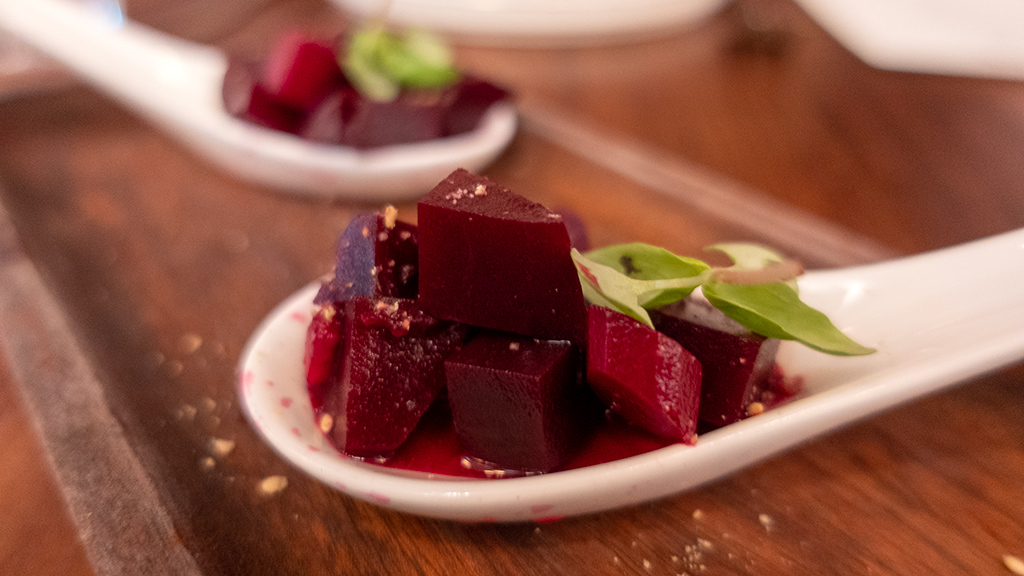
The first dish of my tasting menu was Kaluga caviar and eggs. The caviar was placed atop some bottarga espuma contained in an eggshell, and below the whip was a creamy mixture of egg yolk and trout and salmon roe. I am very disappointed that my camera decided to focus on the spoon instead of the food in both photos I took of this dish, but I still had to include a shot because of how amazing it was.
I don’t know if it was because I had just finished eating the blandest beetroot I have ever had, but the caviar and eggs was an insane explosion of flavor. The caviar had the rich flavor that you’d expect from caviar. The espuma added a nice fluffy texture, but because of the strength of the other flavors, it didn’t throw off the overall profile at all. The inside was incredibly creamy, but did not leave any kind of greasy aftertaste.
I feel like I might have eaten this too quickly, as it was just an overwhelming assault of orgasmic flavors on my taste buds the entire time. It was also unbelievably salty, which I usually do not like, but the salt did not bother me. Salt is great for enhancing flavors, but if there is too much salt and not enough base flavor, the salt just feels like it is pickling the inside of your mouth. Because the caviar, roe, yolk, and cream was so flavorful, the salt had a lot it could work with, so the enhancement effect was on overdrive.
I think I can comfortably say that this is one of my top few favorite dishes I have ever had in my entire life.
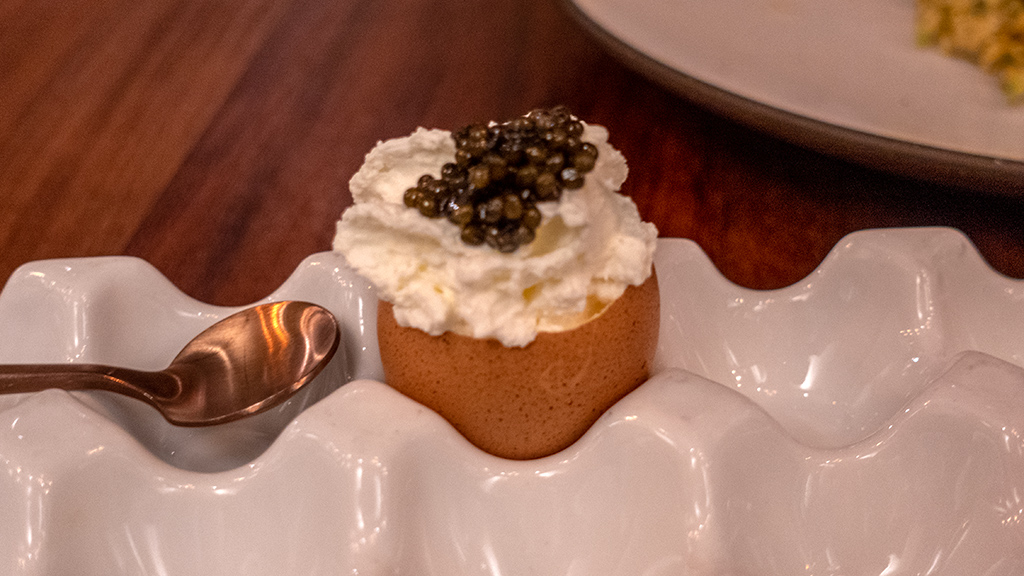
On the vegan side, my friend’s appetizer was farro and haricot vert with green apple and almond topped with cilantro vinaigrette.
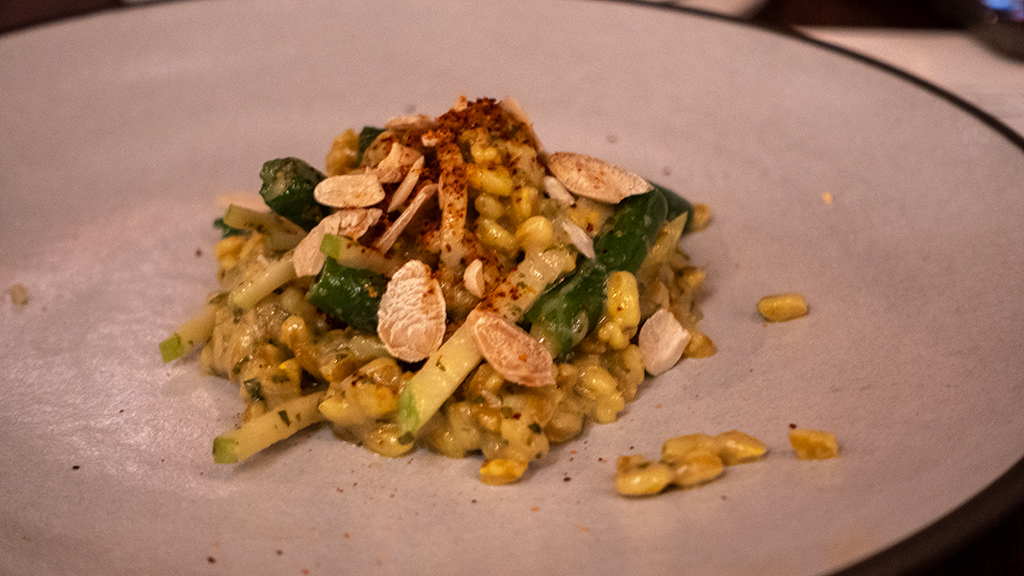
According to the menu, my next dish was supposed to be salame rosa with sunchoke gremolata and chamomile maple syrup. Unfortunately, now that I am organizing my photographs and thinking back, I never received this entrée.
Instead, I went straight to the third dish, Hawaiian tuna sashimi with roasted bell pepper escabeche and balsamic pearls.
I wasn’t a big fan of this one. The escabeche basically tasted like regular salsa you’d find at Whole Foods Market in which you’d dip your tortilla chips while watching American football with your buddies. It was far too sour, which overpowered the tuna to the extent that I couldn’t really tell that I was even eating tuna.
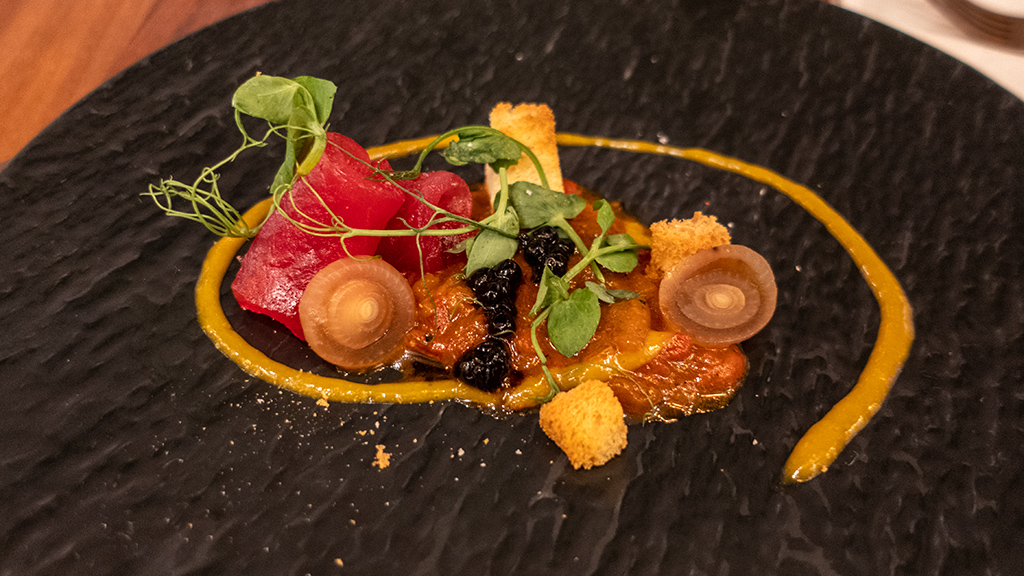
The second dish for the vegan menu was very interesting—it was green tartare made from zucchini, avocado, and green bell pepper topped with a drizzle of pistachio vinaigrette.
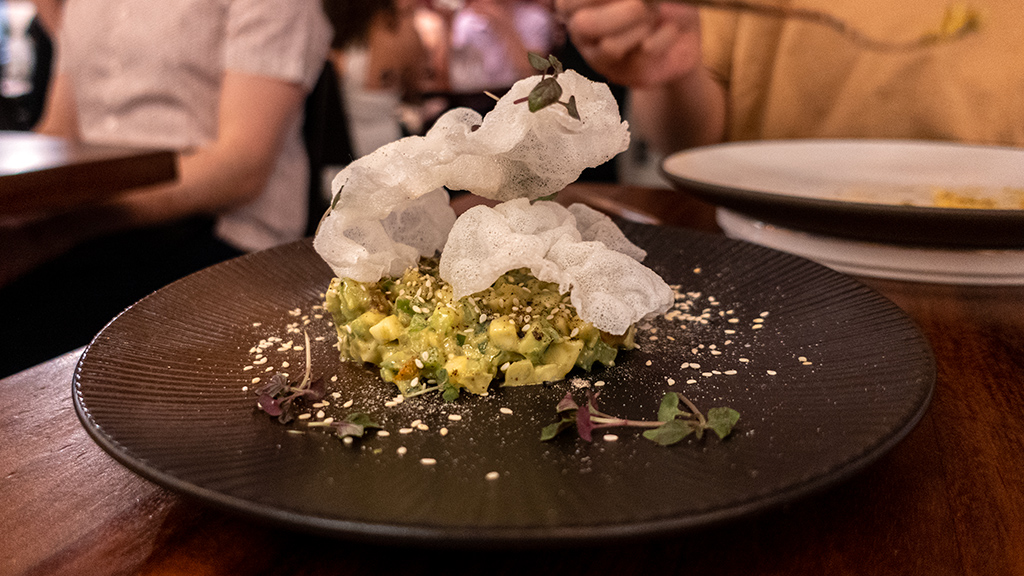
Next up for me was a caprese salad with tomato gelée, balsamic gel, textures of basil, and tomato sand. I’m usually not the biggest fan of tomatoes and will generally only enjoy them in moderation, so when I first received this dish, I was a bit concerned at the large quantity of tomatoes. However, when I started eating, all my worries were dissipated.
The tomatoes were cooked so a lot of their sourness was subdued. The large tomato in the center of the plate was hollowed out in the middle and contained the gelée, which had a deep, rich flavor. The tomato sand added an earthy grit to the texture of the overall dish, and the cracker had a bittery burnt taste that rounded everything out.
Eating any of these components alone would have been underwhelming, but eating all parts together, in rotation, little by little, made this one of the best salads I’ve ever had.
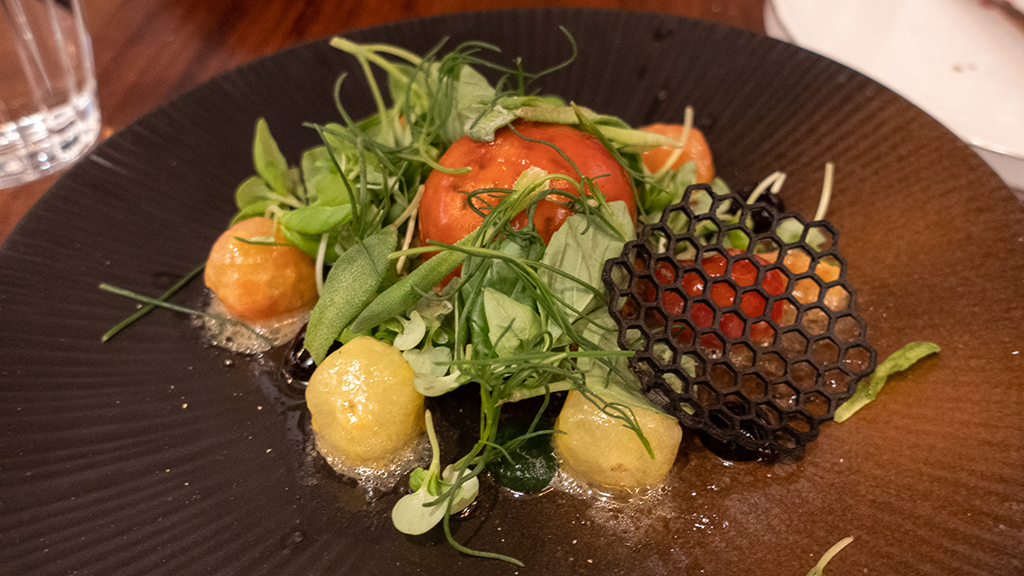
Back to the vegan side, dish number three was a garden vegetable salad with asparagus, eggplant, bell peppers, frisée, and romesco.
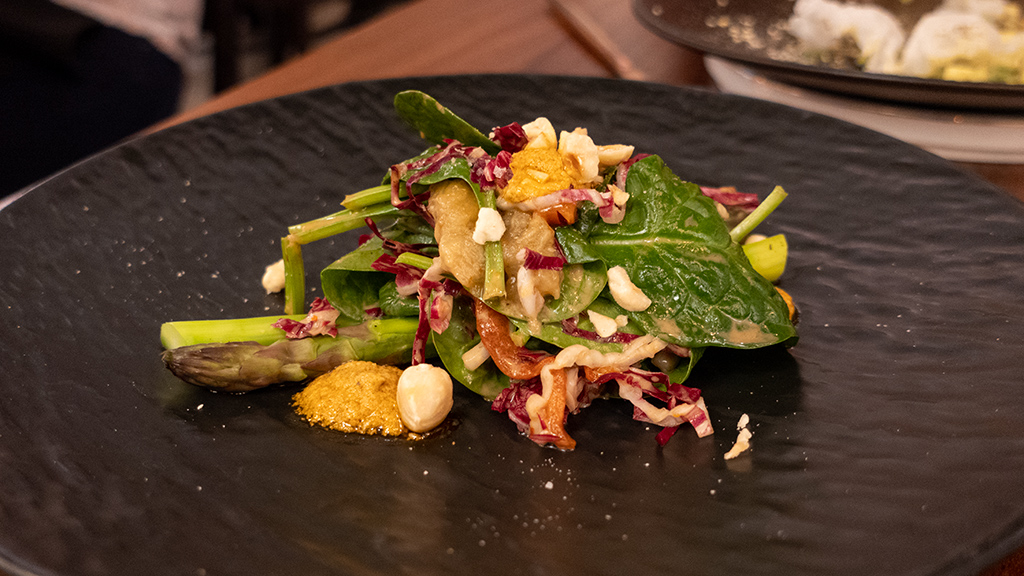
For my normal tasting menu, we were done with the introductory dishes and started getting into the main courses. As a transition dish between the appetizers and main entrées, I was served artichokes tempura with a side of Manzanilla olive hollandaise and pear mostarda.
Tempura usually leaves a greasy aftertaste and the oil stays behind on your fingers, but this chef somehow managed to batter and deep fry the artichokes in a way that didn’t have either of the previous downfalls of fried foods. It wasn’t just straight-up artichokes, though; from what I saw, it looked like the artichoke bracts were delayered, then secured in some sort of flour-based wrapping.
The sauce was unlike anything I had tasted before, and I think the sauce was secretly supposed to be the true star of the dish. The tempura was good, but not crazy in flavor, which I think was intended, because it gave a great base on which the sauce could be applied.
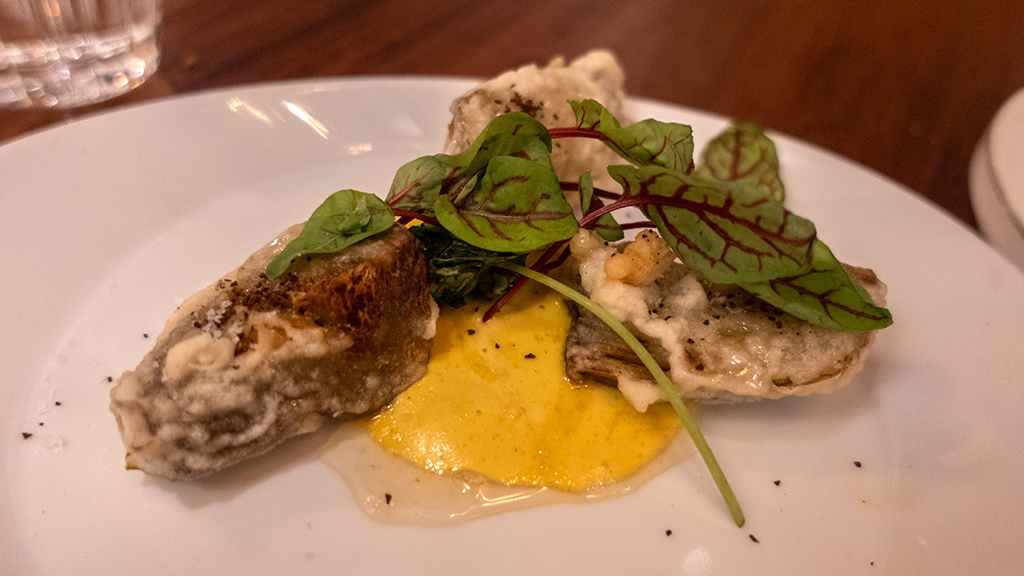
Next for the vegan tasting menu was oven-roasted celery root with truffle vinaigrette. You may notice that the presentation on this dish is a lot worse than the others… and that’s because this was one of those “prepare at your table” dishes.
The waiter brought out a pre-cut celery root standing upright, pressed down on it with a spoon to spread it out, cut open a pouch of truffle vinaigrette, and poured it on top. If I were to put it nicely, the waiter was still learning how to do his part, and hadn’t quite built up the skill and experience yet to stop the root from sticking together and the vinaigrette from clumping up.
Flavor-wise, it was fine. I like cooking with truffle-infused olive oil at home (during the rare times that I do cook), and this dish tasted like what I imagine it would be if I were to just drink out of the olive oil bottle.
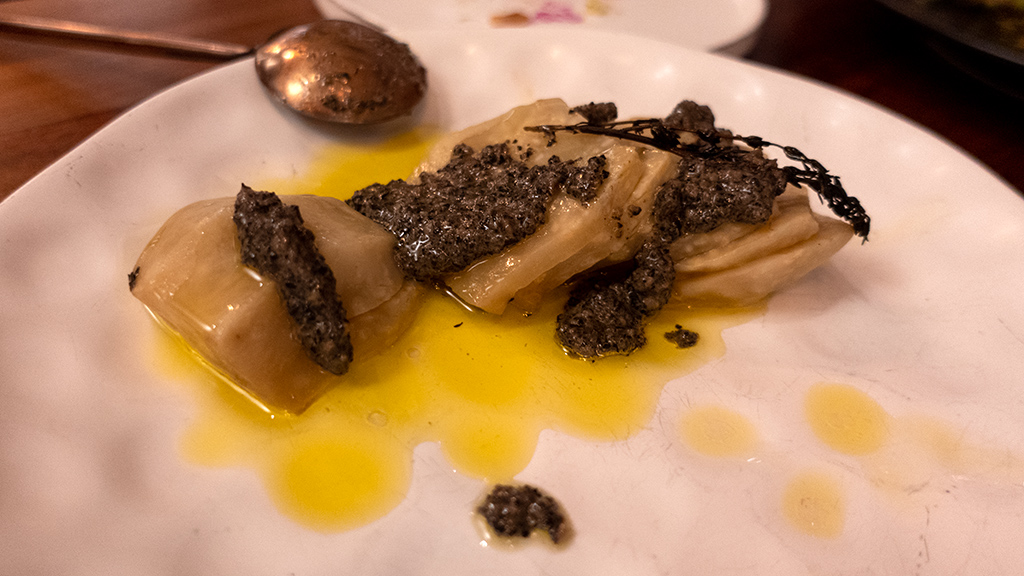
For my main entrées, I was served two pasta dishes. The first was squid ink spaghettini with lump crab, uni, pomodoro, and calabrian chili. Eating this reminded me of the first dish, in that it was just a constant explosion of amazing flavor.
You would think that mixing this many different strong ingredients would just create a jumble of weirdness, but that surprisingly didn’t happen here—I was able to consciously extract and savor each individual flavor, depending on what I was searching for with my taste buds. To top it all off, the texture of the spaghettini was amazing, with a satisfying balance of softness and chewiness.
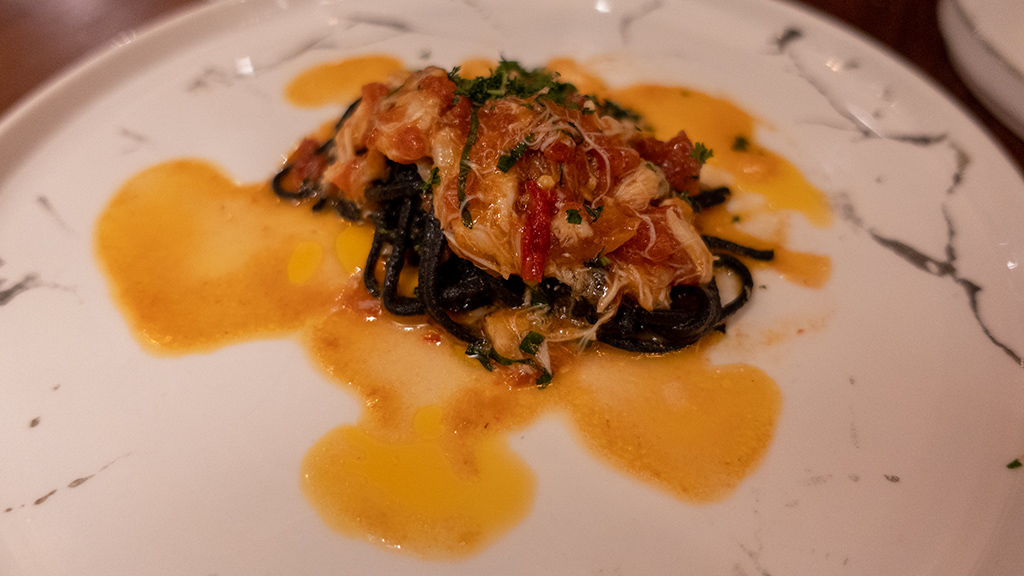
The second pasta was oyster mushroom raviolini with dried figs, chestnuts, and porcini mushroom espuma. I didn’t really have any lasting thoughts about this raviolini, apart from the fact that it was just a solid, well-rounded, delicious raviolini dish. There was nothing notably special about it that I could detect, which, in itself, might have been what was special about it—it was a very “comfortable” dish to eat.
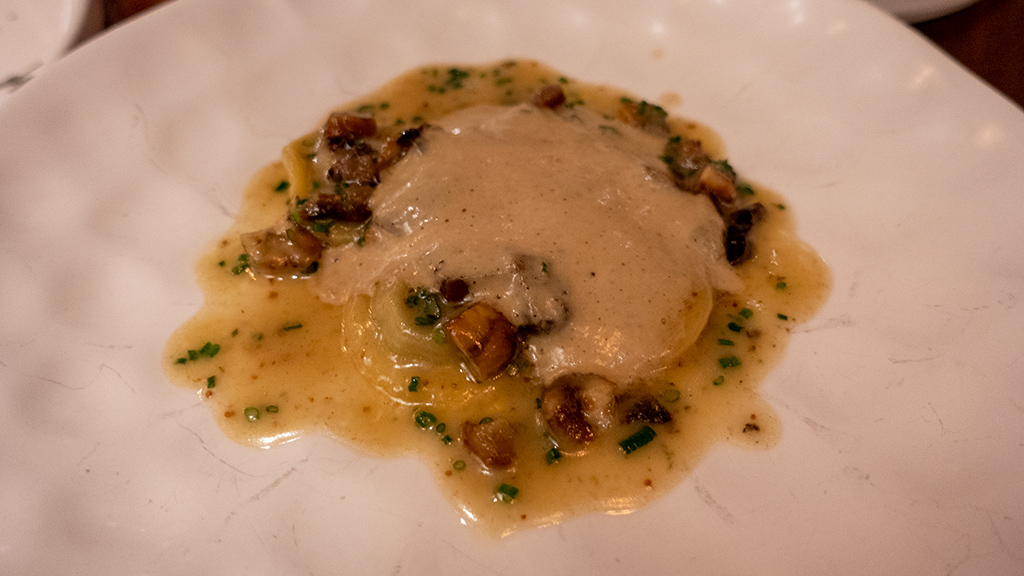
It was time for the grand finale: Washugyu steak.
Washugyu is a special type of wagyu beef cross-bred with Black Angus. Wagyu beef is known for its stunning marbling, which is the even distribution of intramuscular fat across the meat. This restaurant’s Washugyu dish was served next to some burnt onion with koji marinade and alongside a round of bordelaise sauce.
In my opinion, this was actually the worst dish, and I am mostly just confused at it. The meat was cooked blue rare on the inside (which is fine for me, but unusual to serve to the general public in that state of doneness without receiving a special request for it). On the contrary, the outside was burnt (not just charred, but actually burnt).
When I cut into it, the inside had little to no marbling that you expect from wagyu. It wasn’t particularly tender, and it had none of the melt-in-your-mouth texture you expect from wagyu. I could barely taste the steak in general because my taste buds were pummeled by the scowl-inducing bitterness of the badly-burnt crust.
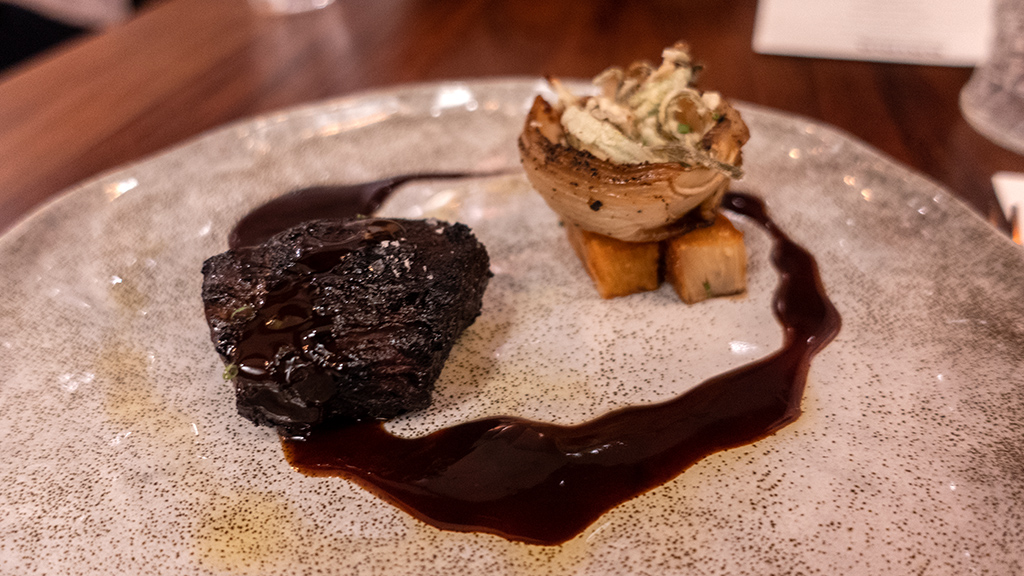
To wrap up the tasting menu, the final dish was the dessert of the day, crème brûlée. The caramelized sugar on top was fun to crack, the custard on bottom was smooth and delicious, and the ratio of the two was nicely balanced—overall, a nice, well-prepared crème brûlée with no frills.
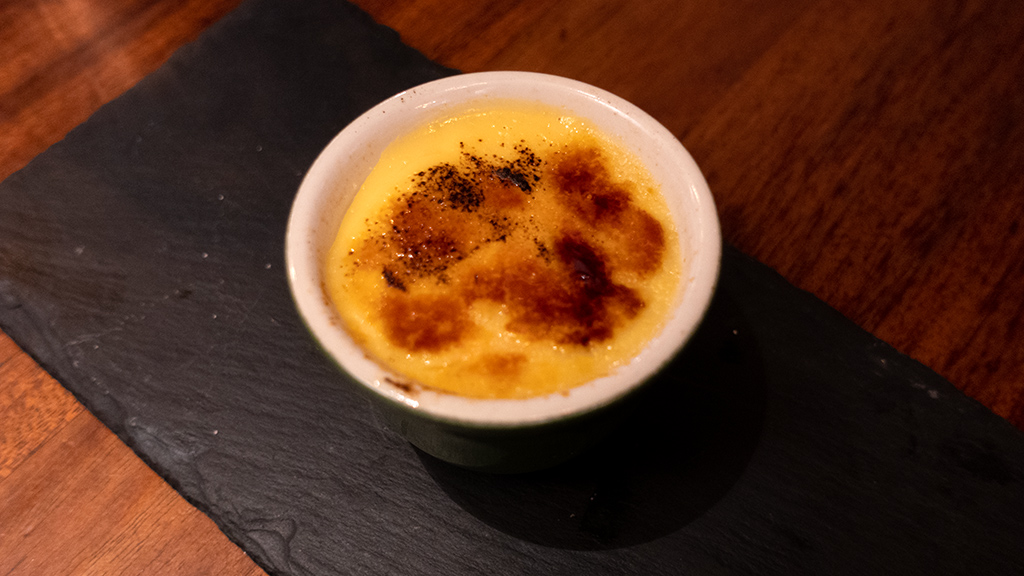
Often, restaurants will try to stand out by crafting very creative dishes that aren’t found anywhere else. Also, often, these attempts end up being a huge hit-or-miss—the restaurant either comes up with an innovative and iconic dish, or it creates some gimmicky Frankensteinian entrée that makes you wonder how it got past quality control.
Anima by EDO is not only a great example of the “hit” in that scenario, but one where it has “hit” multiple times in a row. It serves boldly creative dishes that I have never seen before, and they are amazing. (As a side note, I find it ironic that the one dish that I think they messed up—the wagyu—is a fairly common and “boring” dish to begin with anyway.) It’s not often you come across some food where you think “wow, this is new,” and Anima by EDO managed to give me that eye-sparkling joy four times in a single dinner.
As for the vegan tasting menu, although I’m not a fan of vegan food because I think you miss out on way too much breadth of flavor by cutting out all animal products, I’m still impressed that Anima by EDO managed to come up with seven different interesting gourmet vegan dishes for a seven-course tasting menu. I, of course, would never have it for myself, but if you’re vegan and are sad about the lack of high-end restaurants that make top-tier vegan dishes, then this is a great option.
I’m split in my opinion about the cost. The price of my normal tasting menu was lower than expected, and I think it is very budget-friendly. On the other hand, I’m surprised that the vegan tasting menu’s price was close to mine, and I think the vegan one more closely resembles a high-end luxury restaurant price. This is what we paid:
| Chef’s tasting menu (8 courses) | $ 80.00 |
| Kaluga caviar and eggs add-on course | $ 18.00 |
| Chef’s vegan tasting menu (7 courses) | $ 75.00 |
| Tax (8.375%) | $ 14.49 |
| Gratuity (20%) | $ 34.60 |
| Total | $ 222.09 |
If you’ve been consistently reading my blog, you know that I don’t hand out praise often and only do so when I think it is genuinely deserved. With that being said, I think I am absolutely justified in my overall very positive review. If you’re in the Las Vegas area and want to have a nice dining experience without the chaos and inflated prices of the Strip, I definitely recommend Anima by EDO.